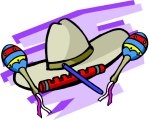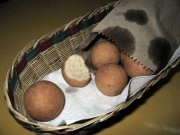
Worksheets and No Prep Teaching Resources
Reading Comprehension Worksheets
Hispanic Heritage

Hispanic Heritage
 Worksheets and No Prep Teaching Resources Reading Comprehension Worksheets Hispanic Heritage |
 Hispanic Heritage |
| edHelper's suggested reading level: | grades 4 to 6 | |
| Flesch-Kincaid grade level: | 5.7 |
|
Sweets for the Sweet
By Jane Runyon |

|
 1 Have you ever eaten in a Mexican restaurant in the U.S.? If you have, you have probably looked at the dessert menu. In the United States, you usually find fried ice cream, sopaipillas, or flan on the menu of a Mexican restaurant. Fried ice cream is usually a scoop of ice cream rolled in corn flakes and then deep fried. Sopaipillas are made with sweet dough. The dough is rolled out and cut into squares. The squares are placed in hot oil to cook. While in the oil, they puff up like a sofa pillow. That's where the name comes from. When the dough is a golden brown, it is taken out of the oil and drained. When it's time to eat a sopaipilla, you bite the corner off and coat the inside with jam or honey. Flan is custard. The top of the custard has been covered with sugar. The sugar is then burned to caramelize it.
1 Have you ever eaten in a Mexican restaurant in the U.S.? If you have, you have probably looked at the dessert menu. In the United States, you usually find fried ice cream, sopaipillas, or flan on the menu of a Mexican restaurant. Fried ice cream is usually a scoop of ice cream rolled in corn flakes and then deep fried. Sopaipillas are made with sweet dough. The dough is rolled out and cut into squares. The squares are placed in hot oil to cook. While in the oil, they puff up like a sofa pillow. That's where the name comes from. When the dough is a golden brown, it is taken out of the oil and drained. When it's time to eat a sopaipilla, you bite the corner off and coat the inside with jam or honey. Flan is custard. The top of the custard has been covered with sugar. The sugar is then burned to caramelize it. |
Create Weekly Reading Books
Prepare for an entire week at once! |
| Leave your feedback on Sweets for the Sweet (use this link if you found an error in the story) |
 |
Hispanic Heritage
|
 |
United States
|
|
|
 | Fifty States Theme Unit |
 |
Document Based Activities |